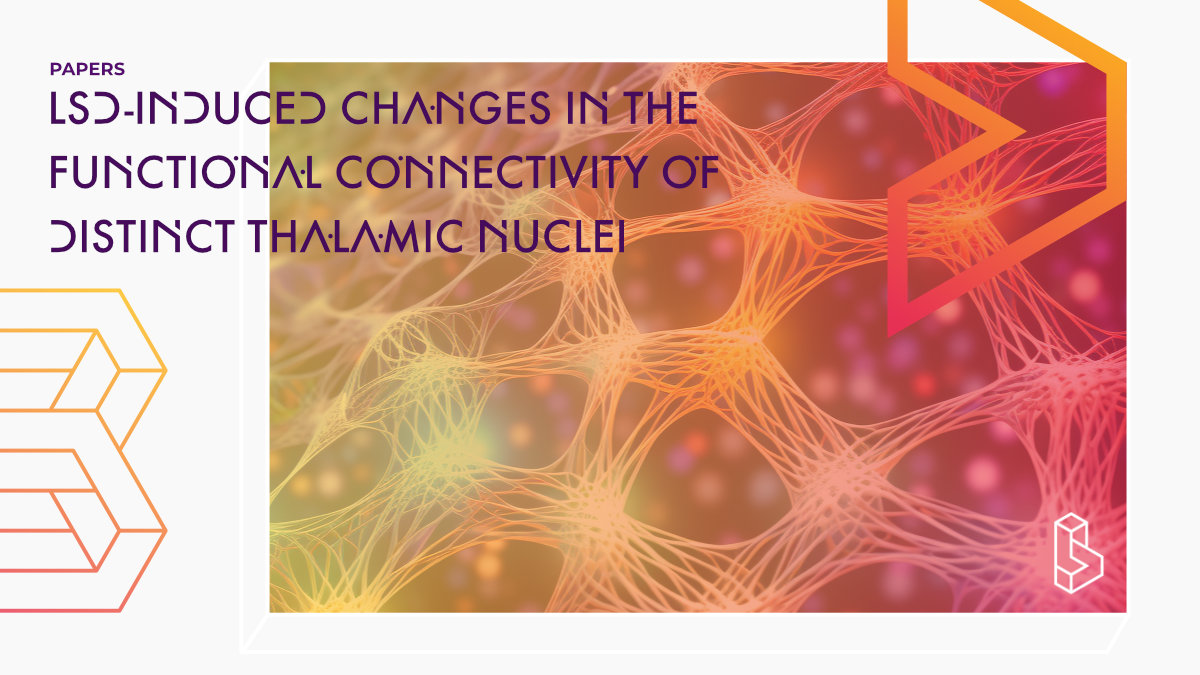This re-analysis study (n=20) investigated the impact of acute LSD (75μg) administration on thalamocortical connectivity in healthy volunteers. The study utilized structural and resting-state fMRI to examine the thalamus at the nucleus-specific level. LSD intake was found to increase functional connectivity between the thalamus’s ventral complex, pulvinar, and non-specific nuclei, particularly with sensory cortices such as somatosensory and auditory networks, as well as parts of the associative cortex dense in serotonin type 2A receptors. The study also reported decreased connectivity between the striatum and thalamus.
Abstract of LSD-induced changes in the functional connectivity of distinct thalamic nuclei
“The role of the thalamus in mediating the effects of lysergic acid diethylamide (LSD) was recently proposed in a model of communication and corroborated by imaging studies. However, a detailed analysis of LSD effects on nuclei-resolved thalamocortical connectivity is still missing. Here, in a group of healthy volunteers, we evaluated whether LSD intake alters the thalamocortical coupling in a nucleus-specific manner. Structural and resting-state functional Magnetic Resonance Imaging (MRI) data were acquired in a placebo-controlled study on subjects exposed to acute LSD administration. Structural MRI was used to parcel the thalamus into its constituent nuclei based on individual anatomy. Nucleus-specific changes of resting-state functional MRI (rs-fMRI) connectivity were mapped using a seed-based approach. LSD intake selectively increased the thalamocortical functional connectivity (FC) of the ventral complex, pulvinar, and non-specific nuclei. Functional coupling was increased between these nuclei and sensory cortices that include the somatosensory and auditory networks. The ventral and pulvinar nuclei also exhibited increased FC with parts of the associative cortex that are dense in serotonin type 2A receptors. These areas are hyperactive and hyper-connected upon LSD intake. At subcortical levels, LSD increased the functional coupling among the thalamus’s ventral, pulvinar, and non-specific nuclei, but decreased the striatal-thalamic connectivity. These findings unravel some LSD effects on the modulation of subcortical-cortical circuits and associated behavioral outputs.”
Authors: Stefano Delli Pizzi, Piero Chiacchiaretta, Carlo Sestieri, Antonio Ferretti, Maria Giulia Tullo, Stefania Della Penna, Giovanni Martinotti, Marco Onofrj, Leor Roseman, Christopher Bernhard Timmermann Slater, David J. Nutt, Robin L. Carhart-Harris & Stefano L. Sensi
Summary of LSD-induced changes in the functional connectivity of distinct thalamic nuclei
Introduction
LSD is a psychoactive drug that alters perception and consciousness. It has regained attention as a way to investigate the neural bases of perception, cognition, and consciousness, and as a supplementary tool for the treatment of psychiatric disorders.
Recent experimental data indicate that subcortical structures play a synergic role with the neocortex in mediating the psychedelic experience. Psychedelic drugs alter the functional connectivity between the thalamus and primary sensory cortices, including the sensorimotor, auditory, and visual networks. The thalamus contains several highly interconnected nuclei of first- and high-order, which contribute to shaping the cortico-cortical communication flows. Although the intralaminar (IT) complex is considered among the high-order nuclei, it shares some functional properties with the first-order nuclei.
Find this paper
LSD-induced changes in the functional connectivity of distinct thalamic nuclei
https://doi.org/10.1016/j.neuroimage.2023.120414
Open Access | Google Scholar | Backup | 🕊
Cite this paper (APA)
Pizzi, S. D., Chiacchiaretta, P., Sestieri, C., Ferretti, A., Tullo, M. G., Della Penna, S., ... & Sensi, S. L. (2023). LSD-induced changes in the functional connectivity of distinct thalamic nuclei. NeuroImage, 120414.
Study details
Compounds studied
LSD
Topics studied
Neuroscience
Study characteristics
Original Re-analysis
Placebo-Controlled
Single-Blind
Within-Subject
Participants
20
Humans
Linked Research Papers
Notable research papers that build on or are influenced by this paper
Neural correlates of the LSD experience revealed by multimodal neuroimagingUsing three different neuroimaging techniques (ASL, BOLD, MEG), this single-blind, placebo-controlled study highlighted the neurological underpinnings of the LSD/psychedelic (75μg) experience.

